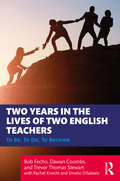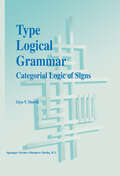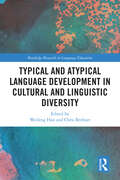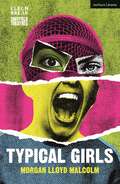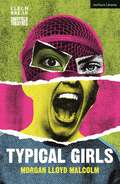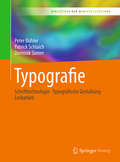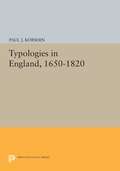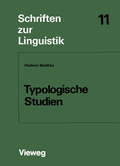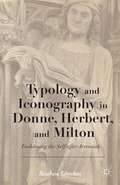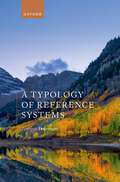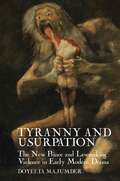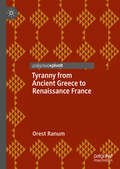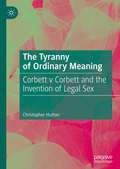- Table View
- List View
Two Years in the Lives of Two English Teachers: To Be, To Do, To Become
by Bob Fecho Dawan Coombs Trevor Thomas Stewart Rachel Knecht Emelio DiSabatoThis book invites readers to explore the complexity of becoming a teacher through the stories of two novice ELA teachers, Emelio and Rachel, over the course of their first two years. The authors’ detailed, empathetic, and ethnographic approach allows space for the teachers to reveal little-seen and often overlooked "wobble moments." These moments illuminate the complexity and nuances that confront, confound, and compel teachers to remain in dialogue with practice. Documenting the journeys of two teachers with compassion and intellectual rigor, this book provides insights into and challenges preconceived notions of what it means to be a teacher. It is essential reading for preservice teachers, scholars, and researchers in English education, as well as individuals considering teaching as a profession.
Two Years in the Lives of Two English Teachers: To Be, To Do, To Become
by Bob Fecho Dawan Coombs Trevor Thomas Stewart Rachel Knecht Emelio DiSabatoThis book invites readers to explore the complexity of becoming a teacher through the stories of two novice ELA teachers, Emelio and Rachel, over the course of their first two years. The authors’ detailed, empathetic, and ethnographic approach allows space for the teachers to reveal little-seen and often overlooked "wobble moments." These moments illuminate the complexity and nuances that confront, confound, and compel teachers to remain in dialogue with practice. Documenting the journeys of two teachers with compassion and intellectual rigor, this book provides insights into and challenges preconceived notions of what it means to be a teacher. It is essential reading for preservice teachers, scholars, and researchers in English education, as well as individuals considering teaching as a profession.
Typical (Oberon Modern Plays)
by Ryan Calais CameronFrom the makers of 2018 hit Queens of Sheba comes this powerful new play by Ryan Calais Cameron, following the events over one typical night out that is turned upside down by racism and police brutality. Typical uncovers the man and the humanity behind a real-life story: a Black ex-serviceman who spent his life fighting for his country and ends up fighting for his life in police custody.
Typical and Atypical Language Development in Cultural and Linguistic Diversity (Routledge Research in Language Education)
by Weifeng Han and Chris BrebnerTypical and Atypical Language Development in Cultural and Linguistic Diversity brings together state-of-the-art studies in both typical and atypical language development. Placing the topic in the context of cultural and linguistic diversity (CALD), the book offers readers serious theoretical consideration of the topic and provides implications for multilingual educational and clinical practices. The content covers a wide range of topics related to multilingual language development in CALD: typical and atypical language development in CALD, and the interface between both; the relationship between multilingual competence and academic performance in CALD; providing unbiased speech and language measures in CALD; and heritage and minority languages education in CALD. Each chapter outlines the core theoretical and practical issues and explores both theoretical and pedagogical/clinical implications in the area and possible future developments. This volume is an essential resource for all those who study, research, or are interested in multilingual development, educational linguistics, and clinical linguistics in the CALD context.
Typical and Atypical Language Development in Cultural and Linguistic Diversity (Routledge Research in Language Education)
Typical and Atypical Language Development in Cultural and Linguistic Diversity brings together state-of-the-art studies in both typical and atypical language development. Placing the topic in the context of cultural and linguistic diversity (CALD), the book offers readers serious theoretical consideration of the topic and provides implications for multilingual educational and clinical practices. The content covers a wide range of topics related to multilingual language development in CALD: typical and atypical language development in CALD, and the interface between both; the relationship between multilingual competence and academic performance in CALD; providing unbiased speech and language measures in CALD; and heritage and minority languages education in CALD. Each chapter outlines the core theoretical and practical issues and explores both theoretical and pedagogical/clinical implications in the area and possible future developments. This volume is an essential resource for all those who study, research, or are interested in multilingual development, educational linguistics, and clinical linguistics in the CALD context.
Typical Girls (Modern Plays)
by Morgan Lloyd MalcolmIn a mental health unit inside a prison, a group of women discover the music of punk rock band The Slits and form their own group. An outlet for their frustration, they find remedy in revolution. But in a system that suffocates, can rebellion ever be allowed?Written by Morgan Lloyd Malcolm (Emilia), Typical Girls is a funny, fierce and furious part-gig, part-play, co-commissioned by Clean Break theatre company.
Typical Girls (Modern Plays)
by Morgan Lloyd MalcolmIn a mental health unit inside a prison, a group of women discover the music of punk rock band The Slits and form their own group. An outlet for their frustration, they find remedy in revolution. But in a system that suffocates, can rebellion ever be allowed?Written by Morgan Lloyd Malcolm (Emilia), Typical Girls is a funny, fierce and furious part-gig, part-play, co-commissioned by Clean Break theatre company.
Typografie: Schrifttechnologie - Typografische Gestaltung - Lesbarkeit (Bibliothek der Mediengestaltung)
by Peter Bühler Patrick Schlaich Dominik SinnerDieser Band der „Bibliothek der Mediengestaltung“ behandelt die Schrifterkennung und Schriftklassifikation, die Lesbarkeit von Schrift und den gestalterischen und technischen Einsatz von Schriften. Außerdem werden die Schrifttechnologie und die Verwaltung von Schriften thematisiert. Für diese Bibliothek wurden die Themen des Kompendiums der Mediengestaltung neu strukturiert, vollständig überarbeitet und in ein handliches Format gebracht. Leitlinien waren hierbei die Anpassung an die Entwicklungen in der Werbe- und Medienbranche sowie die Berücksichtigung der aktuellen Rahmenpläne und Studienordnungen sowie Prüfungsanforderungen der Ausbildungs- und Studiengänge.Die Bände der „Bibliothek der Mediengestaltung“ enthalten zahlreiche praxisorientierte Aufgaben mit Musterlösungen und eignen sich als Lehr- und Arbeitsbücher an Schulen sowie Hochschulen und zum Selbststudium.
The Typographic Imaginary in Early Modern English Literature (Material Readings in Early Modern Culture)
by Rachel StennerThe typographic imaginary is an aesthetic linking authors from William Caxton to Alexander Pope, this study centrally contends. Early modern English literature engages imaginatively with printing and this book both characterizes that engagement and proposes the typographic imaginary as a framework for its analysis. Certain texts, Rachel Stenner states, describe the people, places, concerns, and processes of printing in ways that, over time, generate their own figurative authority. The typographic imaginary is posited as a literary phenomenon shared by different writers, a wider cultural understanding of printing, and a critical concept for unpicking the particular imaginative otherness that printing introduced to literature. Authors use the typographic imaginary to interrogate their place in an evolving media environment, to assess the value of the printed text, and to analyse the roles of other text-producing agents. This book treats a broad array of authors and forms: printers’ manuals; William Caxton’s paratexts; the pamphlet dialogues of Robert Copland and Ned Ward; poetic miscellanies; the prose fictions of William Baldwin, George Gascoigne, and Thomas Nashe; the poetry and prose of Edmund Spenser; writings by John Taylor and Alexander Pope. At its broadest, this study contributes to an understanding of how technology changes cultures. Located at the crossroads between literary, material, and book historical research, the particular intervention that this work makes is threefold. In describing the typographic imaginary, it proposes a new framework for analysis of print culture. It aims to focus critical engagement on symbolic representations of material forms. Finally, it describes a lineage of late medieval and early modern authors, stretching from the mid-fifteenth to the mid-eighteenth centuries, that are linked by their engagement of a particular aesthetic.
The Typographic Imaginary in Early Modern English Literature (Material Readings in Early Modern Culture)
by Rachel StennerThe typographic imaginary is an aesthetic linking authors from William Caxton to Alexander Pope, this study centrally contends. Early modern English literature engages imaginatively with printing and this book both characterizes that engagement and proposes the typographic imaginary as a framework for its analysis. Certain texts, Rachel Stenner states, describe the people, places, concerns, and processes of printing in ways that, over time, generate their own figurative authority. The typographic imaginary is posited as a literary phenomenon shared by different writers, a wider cultural understanding of printing, and a critical concept for unpicking the particular imaginative otherness that printing introduced to literature. Authors use the typographic imaginary to interrogate their place in an evolving media environment, to assess the value of the printed text, and to analyse the roles of other text-producing agents. This book treats a broad array of authors and forms: printers’ manuals; William Caxton’s paratexts; the pamphlet dialogues of Robert Copland and Ned Ward; poetic miscellanies; the prose fictions of William Baldwin, George Gascoigne, and Thomas Nashe; the poetry and prose of Edmund Spenser; writings by John Taylor and Alexander Pope. At its broadest, this study contributes to an understanding of how technology changes cultures. Located at the crossroads between literary, material, and book historical research, the particular intervention that this work makes is threefold. In describing the typographic imaginary, it proposes a new framework for analysis of print culture. It aims to focus critical engagement on symbolic representations of material forms. Finally, it describes a lineage of late medieval and early modern authors, stretching from the mid-fifteenth to the mid-eighteenth centuries, that are linked by their engagement of a particular aesthetic.
Typographies of Performance in Early Modern England
by Claire M. BourneTypographies of Performance in Early Modern England is the first book-length study of early modern English playbook typography. It tells a new history of drama from the period by considering the page designs of plays by Shakespeare and others printed between the end of the fifteenth century and the beginning of the eighteenth century. It argues that typography, broadly conceived, was used creatively by printers, publishers, playwrights, and other agents of the book trade to make the effects of theatricality—from the most basic (textually articulating a change in speaker) to the more complex (registering the kinesis of bodies on stage)—intelligible on the page. The coalescence of these experiments into a uniquely dramatic typography that was constantly responsive to performance effects made it possible for 'plays' to be marketed, collected, and read in the sixteenth and seventeenth centuries as a print genre distinct from all other genres of imaginative writing. It has been said, 'If a play is a book, it is not a play.' Typographies of Performance in Early Modern England shows that 'play' and 'book' were, in fact, mutually constitutive: it was the very bookishness of plays printed in early modern England that allowed them to be recognized by their earliest readers as plays in the first place.
Typographies of Performance in Early Modern England
by Claire M. BourneTypographies of Performance in Early Modern England is the first book-length study of early modern English playbook typography. It tells a new history of drama from the period by considering the page designs of plays by Shakespeare and others printed between the end of the fifteenth century and the beginning of the eighteenth century. It argues that typography, broadly conceived, was used creatively by printers, publishers, playwrights, and other agents of the book trade to make the effects of theatricality—from the most basic (textually articulating a change in speaker) to the more complex (registering the kinesis of bodies on stage)—intelligible on the page. The coalescence of these experiments into a uniquely dramatic typography that was constantly responsive to performance effects made it possible for 'plays' to be marketed, collected, and read in the sixteenth and seventeenth centuries as a print genre distinct from all other genres of imaginative writing. It has been said, 'If a play is a book, it is not a play.' Typographies of Performance in Early Modern England shows that 'play' and 'book' were, in fact, mutually constitutive: it was the very bookishness of plays printed in early modern England that allowed them to be recognized by their earliest readers as plays in the first place.
Typography & Language in Everyday Life: Prescriptions and Practices (Language In Social Life)
by Sue WalkerTypography and Language in Everyday Life provides a detailed look at graphic as well as linguistic aspects of language and suggests there is much to be gained from collaboration between typographers and applied linguists.The first part of the book provides an introduction to aspects of typographic theory and history and suggests some areas of applied linguistics that offer approaches to studying graphic language. The second part comprises case studies which look at the relationship between prescription and practice for visual organisation by considering everyday display typography, house style and typing manuals, and letter-writing. Each of these subjects is looked at from historical and theoretical perspectives.Aimed at those who may be unfamiliar with theoretical and historical perspectives on the graphic aspects of language, and with broad concepts in applied linguistics, the book also directs readers to areas of further reading in each of these fields. Extensively illustrated with examples of past and present graphic language, Typography and Language in Everyday Life is essential reading for students of typography, graphic design, applied linguistics and education, as well as the general reader.
Typography & Language in Everyday Life: Prescriptions and Practices (Language In Social Life)
by Sue WalkerTypography and Language in Everyday Life provides a detailed look at graphic as well as linguistic aspects of language and suggests there is much to be gained from collaboration between typographers and applied linguists.The first part of the book provides an introduction to aspects of typographic theory and history and suggests some areas of applied linguistics that offer approaches to studying graphic language. The second part comprises case studies which look at the relationship between prescription and practice for visual organisation by considering everyday display typography, house style and typing manuals, and letter-writing. Each of these subjects is looked at from historical and theoretical perspectives.Aimed at those who may be unfamiliar with theoretical and historical perspectives on the graphic aspects of language, and with broad concepts in applied linguistics, the book also directs readers to areas of further reading in each of these fields. Extensively illustrated with examples of past and present graphic language, Typography and Language in Everyday Life is essential reading for students of typography, graphic design, applied linguistics and education, as well as the general reader.
The Typological Diversity of Morphomes: A Cross-Linguistic Study of Unnatural Morphology
by Borja HerceThis is an open access title available under the terms of a CC BY-NC-ND 4.0 International licence. It is free to read at Oxford Academic and offered as a free PDF download from OUP and selected open access locations. This is the first typologically-oriented book-length treatment of morphomes, systematic morphological identities, usually within inflectional paradigms, that do not map onto syntactic or semantic natural classes. In the first half of the book, Borja Herce outlines the theoretical and empirical challenges associated with the identification and definition of morphomes, and surveys their links with related notions such as syncretism, homophony, segmentation, and economy, among others. He also presents the different ways in which morphomic structures in a language have been observed to emerge, change, and disappear. The second part of the book contains its core contribution: a database of 120 morphomes across 79 languages from a range of families, which are presented and analysed in detail. A range of findings emerge as a result, including the idiosyncratic nature of morphomes in the Romance languages, the existence of cross-linguistically recurrent unnatural patterns, and the preference for more natural structures even among morphomes. The database also allows further explorations of other issues such as the effect of learnability and communicative efficiency on morphological structures, and the lexical and grammatical informativity of morphs and their distribution.
A Typological Study of the Existential Clause: A Functional Linguistics Perspective
by Wang YongThis book investigates the existential clause (EC) from a cross-linguistic perspective and within the framework of Systemic Functional Linguistics.The prototypical EC in the less familiar languages is identified through its functional equivalents in the more familiar ones, which share the common semantic basis of ‘there exists something in some location’. Topics addressed include the morpho-syntactic features of the EC, the subject of the EC, the definiteness effect and its manifestations in the EC, the EC as impersonals, the distinction between entity- vs. event-existentials, and the EC and its related constructions. Drawing on both cross-linguistic observations based on the language sample and in-depth investigations in particular languages (e.g., in Chinese and English), the study aims to unravel how the lexico-grammar of EC is related to its meanings and functions, that is, how meaning is realised in form.The title will appeal to scholars and students in the field of linguistics, especially functional linguistics, and syntax.
A Typological Study of the Existential Clause: A Functional Linguistics Perspective
by Wang YongThis book investigates the existential clause (EC) from a cross-linguistic perspective and within the framework of Systemic Functional Linguistics.The prototypical EC in the less familiar languages is identified through its functional equivalents in the more familiar ones, which share the common semantic basis of ‘there exists something in some location’. Topics addressed include the morpho-syntactic features of the EC, the subject of the EC, the definiteness effect and its manifestations in the EC, the EC as impersonals, the distinction between entity- vs. event-existentials, and the EC and its related constructions. Drawing on both cross-linguistic observations based on the language sample and in-depth investigations in particular languages (e.g., in Chinese and English), the study aims to unravel how the lexico-grammar of EC is related to its meanings and functions, that is, how meaning is realised in form.The title will appeal to scholars and students in the field of linguistics, especially functional linguistics, and syntax.
Typologies in England, 1650-1820
by Paul J. KorshinProfessor Korshin delineates the development of typology from the theological to the secular sphere through a study of abstracted typology, or types that writers transferred from their customary religious contexts and put into various genres of literature, from poetry and fables to novels and histories.Originally published in 1983.The Princeton Legacy Library uses the latest print-on-demand technology to again make available previously out-of-print books from the distinguished backlist of Princeton University Press. These editions preserve the original texts of these important books while presenting them in durable paperback and hardcover editions. The goal of the Princeton Legacy Library is to vastly increase access to the rich scholarly heritage found in the thousands of books published by Princeton University Press since its founding in 1905.
Typology and Iconography in Donne, Herbert, and Milton: Fashioning the Self after Jeremiah
by Reuben SánchezThis book analyzes the iconographic traditions of Jeremiah and of melancholy to show how Donne, Herbert, and Milton each fashions himself after the icons presented in Rembrandt's Jeremiah Lamenting the Destruction of Jerusalem , Sluter's sculpture of Jeremiah in the Well of Moses, and Michelangelo's fresco of Jeremiah in the Sistine Chapel.
A Typology of Reference Systems
by Zygmunt FrajzyngierThis volume offers a typology of reference systems across a range of typologically and genetically distinct languages, including English, Mandarin, non-literary varieties of Russian, Chadic languages, and a number of understudied Sino-Russian idiolects. The term 'reference system' designates all functions within the grammatical system of a given language that indicate whether and how the addressee(s) should identify the referents of participants in the proposition. In this book, Zygmunt Frajzyngier explores the major functional domains, subdomains, and individual functions that determine the identification of participants in a given language, and outlines which are the most and least frequently found crosslinguistically. The findings reveal that bare nouns, pronouns, demonstratives and determiners, and coding on the verb ('agreement') have different functions in different languages. The concluding chapters offer explanations for these differences and explore their implications for the theory and methodology of syntactic analysis, for linguistic typology, and for syntactic theories.
Tyranny and Usurpation: The New Prince and Lawmaking Violence in Early Modern Drama (English Association Monographs: English at the Interface #5)
by Doyeeta MajumderIn the middle years of the sixteenth century, English drama witnessed the emergence of the ‘tyrant by entrie’ or the usurper, who supplanted earlier ‘tyrant by the administration’ as the main antihero of political drama. This usurper or, in Machiavellian terms principe nuove, was the prince without dynastic claims who creates his sovereignty by dint of his own ‘virtù’ and through an act of ‘lawmaking’ violence. Early Tudor morality plays were exclusively concerned with the legitimate monarch who becomes a tyrant; in the political drama of the first half of the sixteenth century, we do not encounter a single instance of usurpation among the texts that are still available to us. In contrast, the historical and tragic plays of the late Elizabethan and Jacobean periods teem with illegitimate monarchs. Almost all of Shakespeare’s history plays, at least four of his ten tragedies, and even a few of his comedies feature usurpation or potential usurpation of sovereign power as a crucial plot device. Why and how does usurpation emerge as a preoccupation in English theatre? What are the political, historical, legal, and dramaturgical transformations that influence and are influenced by this moment of emergence? As the first book-length study devoted exclusively to the study of usurpation and tyranny in sixteenth-century drama and politics, Tyranny and Usurpation: The New Prince and Lawmaking Violence will challenge existing disciplinary boundaries in order to engage with these critical questions.
Tyranny from Ancient Greece to Renaissance France
by Orest RanumThis Palgrave Pivot examines how prominent thinkers throughout history, from ancient Greece to sixteenth-century France, have perceived tyrants and tyranny. Ancient philosophers such as Plato and Aristotle were the first to build a vocabulary for tyrants and the forms of government they corrupted. Thirteenth century analyses of tyranny by Thomas Aquinas and John of Salisbury, revived from Antiquity, were recast as short observations about what tyrants do. They claimed that tyrants govern for their own advantage, not for the people. Tyrants could be usurpers, increase taxes, and live in luxury. The list of tyrannical actions grew over time, especially in periods of turmoil and civil war, often raising the question: When can a tyrant be legitimately deposed or killed? In offering a brief biography of these political philosophers, including Machiavelli, Erasmus, More, Bodin, and others, along with their views on tyrannical behavior, Orest Ranum reveals how the concept of tyranny has been shaped over time, and how it still persists in political thought to this day.
The Tyranny of Ordinary Meaning: Corbett v Corbett and the Invention of Legal Sex
by Christopher HuttonThis book offers an in-depth analysis of the case of Corbett v Corbett, a landmark in terms of law’s engagement with sexual identity, marriage, and transgender rights. The judgement was handed down in 1970, but the decision has shaped decades of debate about the law’s control and recognition of non-normative gender identities. The decision in this case – that the marriage between the Hon. Arthur Corbett and April Ashley was void on the grounds that April Ashley had been born male – has been profoundly influential across the common law world, and came as a dramatic and intolerant intervention in developing discussions about the relationships between medicine, law, questions of sex versus gender, and personal identity. The case raises fundamental questions concerning law in its historical and intellectual context, in particular relating to the centrality of ordinary language for legal interpretation, and this book will be of interest to students and scholars of language and law, legal history, gender and sexuality.
